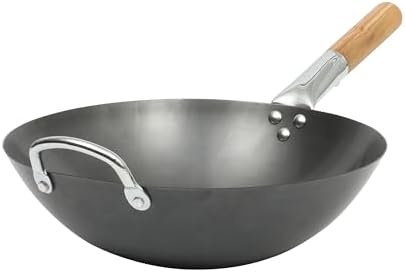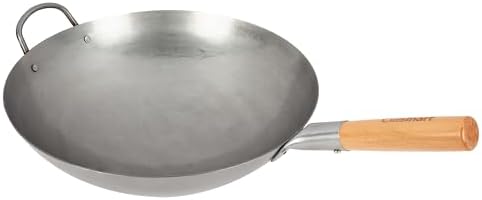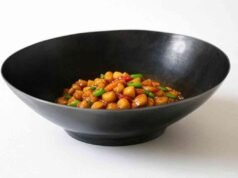Knowing Wok Materials
The material of your wok significantly impacts its cooking performance, longevity, and maintenance. Carbon steel, stainless steel, cast iron, and non-stick coating are some of the most common. They all have their own share of advantages and disadvantages.
Professional chefs often favor carbon steel. It conducts heat excellently and responds quickly to temperature changes. This material heats up rapidly. This enables high-heat stir-frying. However, carbon steel woks need seasoning. This develops a natural non-stick patina, which deters some users. Regular maintenance prevents rusting. Those who invest the time find carbon steel woks unmatched in cooking performance.
Conversely, people praise stainless steel woks for their durability and corrosion resistance. They are non-reactive to acidic foods. This renders them versatile. Nevertheless, stainless steel is less conductive than carbon steel. This can lead to uneven cooking if you are not attentive. These woks are generally low-maintenance and dishwasher-safe. However, they may not be capable of achieving the genuine stir-fried flavor of seasoned carbon steel woks.
Cast iron woks retain heat very well. This serves to make them perfect for slow cooking. They can be heavy and somewhat hard to handle, however. Like carbon steel, cast iron woks also need to be seasoned. This works to maintain their non-stick quality along with preventing rust. They also have the capability of imparting a specific taste to food. This works to enhance the overall gastronomic experience.
Non-stick woks are easy to use and convenient. Particularly for novice cooks. They require less oil and are simpler to clean. However, the durability of the non-stick coating varies. It can be damaged by high heat. Therefore, careful cooking techniques have to be employed. This helps preserve non-stick surfaces.
Finally, the material of the wok greatly affects your cooking method, retention of flavors, and satisfaction overall. Think about your cooking habits and desire to take care of it. This will assist in choosing the correct wok material for your kitchen.
Wok Size and Shape Considerations
In choosing the ideal wok, shape and size are very important. They greatly affect your cooking process. The sizes of woks usually vary from 10 to 16 inches in diameter. Your choice should suit the number of people you cook for. It should also suit the type of dish that you prepare. For instance, a 14-inch wok usually suits families that consist of four or more. A smaller 10-inch wok can serve one or two persons. Additionally, the type of stove you use—gas or electric—affects the choice. Gas stoves provide higher heat output. This makes it convenient to use larger woks.
The shape of the wok flat-bottom or round-bottom—also plays a big role in cooking performance. People like traditional round-bottom woks. That is because they have a tendency for even heat circulation. This is particularly handy for stir-frying. They allow oil to pool at the bottom. This provides for quick cooking. It also assists in achieving desired wok hei flavors. However, round-bottom woks need a round burner or a wok ring. This provides stability and performance on flat stovetops. Examples include those on electric ranges.
Flat-bottom woks, nonetheless, have gained popularity. This is due to the fact that they are adaptable to modern gas and electric stoves. They provide a steady cooking surface. They also provide additional contact with the heating element. This renders them better for steaming or sautéing. Their shape renders them simpler to manage. It can also provide a more adaptable cooking alternative. Lastly, the choice between a round-bottom and flat-bottom wok ultimately depends on cooking style. People who prefer quick, high-heat stir-frying should go with a round-bottom wok. People who prefer versatility may fare well with a flat-bottom alternative. Taking these elements into consideration, then, ensures a perfect cooking experience. This experience will be tailored to your needs.
Essential Features and Accessories
When selecting the ideal wok for your cooking needs, consider several important features. These directly affect its functionality and your overall cooking experience. One primary feature to evaluate is the handle design. A wok can have either a long or a short handle. Each offers distinct benefits. A long handle allows better leverage. This makes it easier to toss ingredients. A short handle provides greater stability. This is for those who prefer a more controlled approach. Depending on your cooking style, choosing the right handle can significantly enhance your ability to maneuver the wok while cooking.
The weight of the wok is also important. Heavier woks hold heat better. They also provide a smoother cooking surface. Woks that are lighter may be easier to handle. This is especially helpful for cooking that requires a high level of movement. You will need to choose a weight that is compatible with your physical strength and cooking style. As you are thinking about the weight, consider how often you will be using the wok. Versatile uses may be worth the investment in a heavier model.
Other than handles and weight, look for simple accessories. They can streamline your cooking. A fitting lid is essential for those who enjoy steaming or braising. It traps flavors and moisture during cooking. Likewise, a quality spatula designed for wok cooking facilitates easy stirring, turning, and scraping. It prevents surface damage to the wok. While deciding, remember what accessories would best go along with your cooking. This will tailor your decision to your cooking needs and style.
Tips for Caring for and Maintaining Your Wok
Proper care and maintenance of your wok is the most important thing. This will ensure that it lasts longer and maintains its performance while cooking. The following tips will help keep your wok in new condition. This is irrespective of whether it’s carbon steel or non-stick coated.
For carbon steel woks, the first thing is seasoning. Seasoning involves applying a thin layer of oil on the wok’s surface. Heat it then until it smokes. This creates a natural non-stick surface. This contributes flavor and prevents rust. You must re-season your wok regularly. Do this especially if you notice that food is starting to stick or the surface is looking dull. Use vegetable or flaxseed oil for the best results. Never cook acidic foods in a wok after it has been re-seasoned. They will remove the seasoning.
It is also necessary to clean your wok after each use. For carbon steel woks, avoid using soap. It will remove the seasoning. Just brush the surface with a soft brush or sponge and hot water. This will remove food particles. Rinse and dry the wok thoroughly under low heat. Then apply a thin layer of oil to prevent rust. If your wok has a non-stick coating, use mild detergents and soft sponges. This will leave the surface intact. The use of abrasive cleansers can erode this thin layer of protection.
To prevent rust, never store your wok in a damp place. If you live in a humid environment, store it with rice or other desiccants. And never use utensils that will scratch the wok’s surface. This will also undermine the quality of cooking over time. Keeping a close eye on these common mistakes will ensure that your wok will remain a faithful kitchen companion for years to come.












